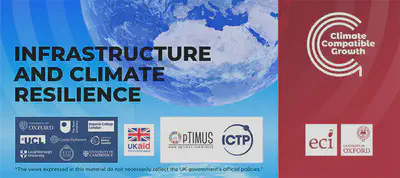CCG101: Infrastructure for sustainable development

Table of Contents
Program overview
Contextualises infrastructure systems within key global agendas, such as the Sustainable Development Goals (SDGs) and the Paris Agreement, and describes approaches for setting national visions and targets and how those may be achieved with particular strategies.
What you will learn
- Fundamental concepts of sustainable development of infrastructure systems
- Decision analysis strategies for long term infrastructure planning
- Planning strategies used in real-world cases
Courses in this program
Lecture 1: Infrastructure for sustainable development
This lecture block introduces the course, the concept of sustainable development and its application to infrastructure systems. First, the general structure of the course is outlined. Next, the first content lecture looks at sustainable development and its formalisation through universal development agendas such as the Sustainable Development Goals (SDGs) and the Paris Agreement, and the role of infrastructure in achieving these objectives.
Lecture 2: Infrastructure to deliver on the Paris Agreement
The Paris Agreement aims to contain global warming to at most 2o C above pre-industrial levels by 2050. As part of the Agreement, signatories have committed to reducing their greenhouse gas emissions through mitigation actions.
Lecture 3: Collecting infrastructure data
Lecture 3 outlines key principles for collecting infrastructure data. Collecting infrastructure data is the first step in evidence-based infrastructure development processes. It is the foundation for estimating future infrastructure needs, setting targets, developing scenarios, and ultimately choosing optimal infrastructure development pathways.
Lecture 4: Future infrastructure demand
This lecture block introduces important concepts for infrastructure demand estimation, including main drivers and important scenario analysis methods, such as the Shared Socio-economic Pathways (SSPs). This lecture block discusses specific drivers and considerations for the process of demand forecasting and exemplifies the learning outcomes through practical applications in developing country contexts.
Lecture 5: Infrastructure vision and targets
This lecture block introduces approaches to assessing infrastructure and setting performance targets. First, past approaches to infrastructure performance assessment are reviewed. Next, the use of sustainable development criteria in assessing infrastructure through the Sustainable Development Goals (SDGs) framework is discussed.
Lecture 6: Infrastructure strategies: Why, what and how
This lecture block introduces the concept of infrastructure strategies, which are sets of future intervention or investment plans in infrastructure systems. Firstly, infrastructure strategies are defined and their usefulness for strategic infrastructure planning is discussed.
Lecture 7: Decision analysis for long-term infrastructure planning
This lecture block introduces several concepts of decision-making under different contexts applicable to infrastructure. These include multiple stakeholders, infrastructure interdependencies and deep uncertainties in future forecasts. Some of these concepts are then showcased in real applications of the NISMOD-Int tool to developing countries.